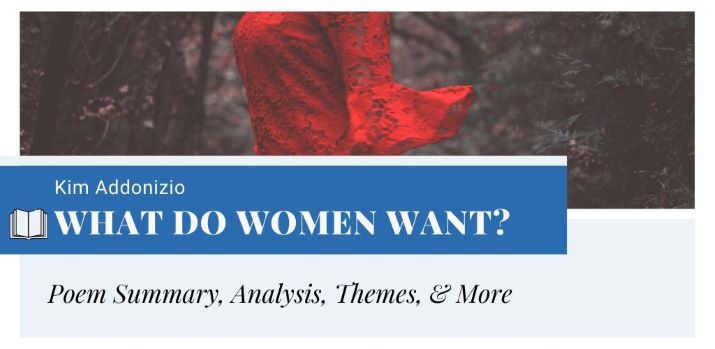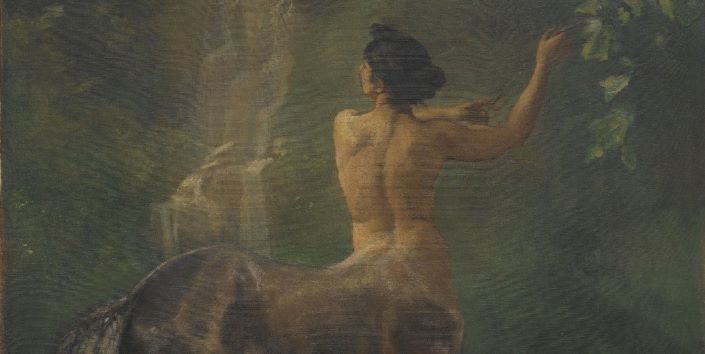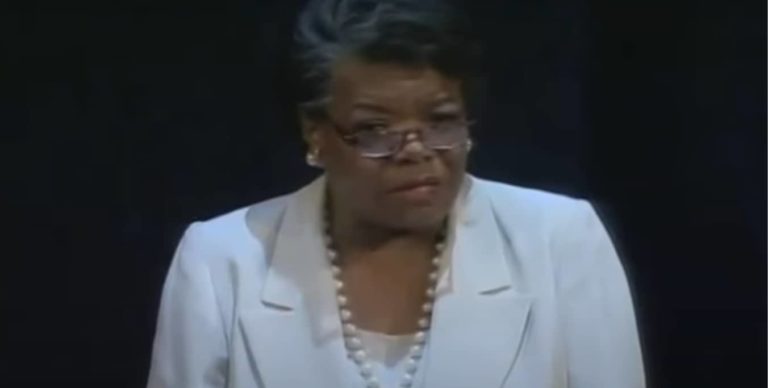What Do Women Want? by Kim Addonizio
“What Do Women Want?” is not a question that confuses an early beginner but also confuses a woman. What do women really want? Is it only love or something materialistic? Does she need a person to hold her tight in the storms of life or a comfort-giver during her painful nights? The question is by no means a silly one. It even confused the well-known Austrian neurologist and the founder of psychoanalysis Sigmund Freud! He once said to Marie Bonaparte:
The great question that has never been answered, and which I have not yet been able to answer, despite my thirty years of research into the feminine soul, is “What does a woman want?”
Sigmund Freud: Life and Work (Hogarth Press, 1953) by Ernest Jones, Vol. 2, Pt. 3, Ch. 16, p. 421. In a footnote Jones presents the original German version of the quote, “Was will das Weib?”
But, in this poem, Kim Addonizio tries to answer this question through her poetic persona. If Freud would have been alive today, he might have had food for thought!
- Read the full text of “What Do Women Want?“

Summary
The speaker (the poetic persona of Kim Addonizio) reveals how she is badly in love with a red dress in the first line of the poem “What Do Women Want?” She wants this dress to be cheap and its quality has to be thin and light. This dress must be sleeveless and backless in order to reveal the lucrative parts of her body. She wants to show it and make the onlookers guess what she is wearing beneath the dress.
She would like to walk in that dress in her familiar neighborhood. When she would cross, everybody would look at her as if she was the only woman in the world. Then she would pick anyone from her admirers.
Her need for the dress may tap the worst insecurities of her partner’s heart. Furthermore, she describes how she is going to pick the dress from the hanger. She thinks the red dress can provide him a body to shelter her true self. By the end, she wishes to be buried in that dress when she dies as she relates it as part of her body.
Meaning
The title of this piece “What Do Women Want?” is an allusion to Sigmund Freud’s famous quote “Was will das Weib?” Freud spent over thirty years of his life enquiring into the mind of human beings. Yet, he could not find the answer to this question. It seems he was being sarcastic regarding the topic.
Whatsoever, in this poem, Addonizio answers this question in bold and physically arousing terms. She reveals her true self to her readers by revealing what she badly wants. Though her thoughts center on a particular red dress, it explores some deeper thoughts through this metaphor.
The dress is actually a metaphorical medium that helps a soul to transcend the boundaries and reveal its true nature. Addonizio’s persona connects this dress to her own body. She thinks of it as an integral part of herself. In this way, Addonizio describes the nature of feminine desire and the intricacies of their mind.
Form, Rhyme Scheme, & Meter
Form
Kim Addonizio wrote this poem “What Do Women Want?” in free-verse form. It means this piece does not have a regular rhyme scheme or meter. Addonizio speaks directly through her poetic persona by using the pronoun “I”. She repeats the word a number of times to emphasize her desire. For this reason, it is an example of a lyric poem.
The overall poem consists of 27 lines with uneven lengths. Some lines end shortly while some other lines are comparably longer. Addonizio uses end-stopped lines to make her readers focus on the idea present in the line.
Rhyme Scheme
Readers can find a few instances rhyming in the following words:
- “backless” and “guess” (lines 5 & 6)
- “through” and “too” (lines 23 & 24)
- “skin” and “in” (lines 25 & 27)
- “dolly” and “only” (lines 12 & 14)
The first three examples are perfect rhymes. While the last one is an example of slant rhyme.
Meter
Regarding the meter, the poem does not have a regular metrical pattern. It consists of both the iambic and trochaic feet. In some instances, readers can also find the use of spondees and other metrical feet. Let’s have a look at the scansion of the first few lines:
I want/ a red dress
I want/ it flim/-sy and cheap,
I want/ it too tight,/ I want/ to wear it
un/-til some/-one tears/ it off me.
In this excerpt, Addonizio employs iambic, trochaic, and bacchius feet.
Poetic Devices & Figurative Language
In this poem, Kim Addonizio uses several poetic devices. The most important ones are mentioned below with examples from the text.
Repetition
Addonizio repeats the phrase “I want” a total of ten times within the text. This repetition is meant for highlighting the speaker’s wish. It is also used to emphasize her identity and subjectivity. Readers can easily scan the repetition from the first three lines of the poem.
Anaphora
The first three lines of the poem begin with the same phrase “I want”.
I want a red dress
I want it flimsy and cheap,
I want it too tight, I want to wear it
This phrase also repeated within the next half of the third line. Addonizio uses the same device in the 15th and 16th lines.
Enjambment
This device is used a number of times. Let’s have a look at a few examples first:
- “I want it too tight, I want to wear it/ until someone tears it off me.”
- “so no one has to guess/ what’s underneath.”
In these examples, a reader has to quickly read both lines to understand the meaning. It is because the poet uses enjambment here.
This device can also be found in the following lines:
- Lines 7-13
- Lines 14-15
- Lines 17-21
- Lines 21-27
Alliteration
Let’s have a look at some examples from the text where Addonizio repeats similar sounds to create internal rhyming.
- “red dress”
- “want it too tight”
- “sleeveless and backless,/ this dress” (a type of sibilance)
- “want to walk”
- “day-old/ donuts”
- “slick snouts”
- “goddamned/ dress,” etc.
Innuendo
Addonizio uses innuendo to hint at something else in a roundabout manner. It occurs in the following examples:
- “I want to wear it/ until someone tears it off me.”
- “so no one has to guess/ what’s underneath”
The first example contains sexual innuendo. In the next one, she refers to her intimate parts by referring to “what’s underneath”.
Hyperbole
The use of exaggerated language that are meant for the sake of emphasis can be found in the following lines:
- “I want it too tight”
- “I want to walk like I’m the only/ woman on earth…”
- “your worst fears about me”
Simile
Readers can find the use of simile in the following examples:
- “I want to walk like I’m the only/ woman on earth”
- “… from its hanger like I’m choosing a body”
- “I’ll wear it like bones, like skin”
In the first example, the speaker compares herself to the only woman on the planet. The following examples contain a comparison between the dress and the human body.
Metaphor
- Addonizio uses a metaphor in “slick snouts”. It is an implicit reference to the pigs.
- She metaphorically compares the dress to a body that shelters the soul. There is also a comparison between the dress and skin and bones.
Paradox
The last two lines of the poem “it’ll be the goddamned/ dress they bury me in” contains a paradoxical idea. If the speaker is so attached to the dress, why does she want to be buried in it? She says to highlight her attachment to the dress. While dying, she is not going to leave the dress behind as it is part of her body, like her skin and bones.
Line-by-Line Analysis & Explanation
Lines 1-4
I want a red …
… someone tears it off me.
The poem “What Do Women Want?” begins with the main idea that centers around a lucrative red dress. Addonizio’s persona in a nagging tone wishes to be in possession of this dress. In the following lines, the poet uses descriptive imagery to depict the dress. According to the speaker, she wants it “flimsy” and “cheap”.
Flimsy means light and thin. This term refers to the transparent nature of the cloth. It would allow her to reveal her lucrative body parts. She does not shy away while revealing her body. Rather she badly wants to show it without caring much about society’s reaction.
The term “cheap” as readers know refers to the price of the dress. Women, in general, like garments that are great in quality but economical in price. Likewise, the speaker does not want to spend much on that dress though she badly wants it.
The dress has to fit tightly on her body. It would make her look more attractive to the opposite sex. When she puts on the dress, it will make her partner tear it off from her body. So, the dress has to be capable of arousing passion in one’s heart. In this way, the first four lines describe what are the things that the poet personally wants, not women in general. However, some of her wishes overlap with those of others.
Lines 5-7
I want it sleeveless …
… underneath.
The first line of this section presents another feature of the dress. According to the speaker, she wants the dress sleeveless and backless. As the dress is flimsy, anyone can guess what she is wearing beneath the dress. Addonizio uses circumlocution to refer to this fact. She says, “no one has to guess/ what’s underneath”. It means anyone can guess what she is wearing under the dress.
This line also hints at the speaker’s mind. She is trying to say that by looking at her dress one can guess what kind of a lady she is. To clarify, she is such a person who is not ashamed of revealing her body. It is a thing that is cherished with eyes. The more one looks at it, the more he gets attracted like a bee to a flower.
Lines 7-13
… I want to …
… snouts over their shoulders.
The first line of this section is enjambed with the following line. Here, the speaker expresses that she wants to walk down the street, past the Thrifty’s Ice-cream store and the hardware store. It seems that she is referring to her neighborhood where she regularly commutes. She can imagine every shop located there.
Whatsoever, she talks about walking past the hardware store where all the “glittering” keys are showcased in the window. The term “glittering” refers to the shine of the new keys. Like the keys are showcased to attract customers, she wishes to reveal herself to attract more males. When a lady senses a fair number of men are attracted to her, it somehow pumps up her confidence. It is also the same with the opposite sex.
Furthermore, she refers to Mr. and Mrs. Wong’s café. She humorously says that they sell day-old donuts in their shop. There are Guerra brothers who sell pigs. They are unloading the pigs from a truck and putting them onto a dolly.
Lines 14-21
I want to walk like …
… I want.
In the poem “What Do Women Want?”, Addonizio repeats the phrase “I want” a fair number of times. This section also begins with the phrase. Here, the poet reveals another thing that women want. They like men trotting around them. It makes a woman feel on top of the universe. Our speaker also wants to feel the same by wearing an attractive dress. To emphasize her desire, she says, “I want that red dress bad.”
In the following line, the poet depicts her naughtiness. She teases her partner by saying that she values the dress more than him. It will make him feel insecure. However, the speaker’s following remark, “to show how little I care about you/ or anything except …” describes the fact that she does not care for anything except what she wants (the red dress). When she wants a thing badly, she acts like a child. She forgets that she can even live without this dress.
Lines 21-27
… When I find it, I’ll put …
… bury me in.
The last section of the poem illustrates what the speaker is going to do when she gets the dress. Like a soul longing for a body, she will pull the dress from its hanger. In the following line “to carry me into this world”, she uses a metaphor. Here, she compares the dress to a body that helps a soul come into the world. In this way, Addonizio dives into the spiritual level with this dress.
When she gets the dress, she will cry like a woman in her labor. Here, Addonizio uses auditory imagery by using the terms “birth-cries” and “love-cries”. In the following line, she compares the dress to her bones and skin in order to portray her attachment to it. She is so fond of that dress that she wishes to be buried in it.
It is important to note the word “goddamn”. We generally use this word while expressing our annoyance. But, here the speaker is using it to portray the opposite. This figurative device is known as irony. Besides, here readers can find the use of paradox. To understand how it is used, let’s ask ourselves a question, “Why does the speaker want to be buried within the dress if she liked it that much?” The reason is that she is in love with the dress and considers it as part of her body. That’s why she does not want to leave it behind.
Themes
Kim Addonizio’s “What Do Women Want?” explores the themes of body, clothing, femininity, individualism, and desire. The most important themes of this piece are the body and clothing. Addonizio fuses them together to describe how she takes pride in her body as well as the dress she wears. The dress to her is like a body to the soul. Therefore she is not ashamed of it if it reveals her intimate parts.
Regarding showing her body, she celebrates femininity in this poem. Her persona loves her feminine beauty and adores herself. She likes to see men hovering around her. It boosts her confidence in being a woman.
Apart from that, the theme of desire is another integral part of the text. Throughout the piece, Addonzio talks about women’s desires. However, in most instances, her desires sound typical yet they reveal some deeper concepts as well.
Historical Background
The poem “What Do Women Want?” was published in Kim Addonizio’s poetry collection, Tell Me. It was published in 2000. She was selected as a finalist at the National Book Award for this collection of poetry. In her poem “What Do Women Want?” she reveals her strong tone of individualism by talking about what she wants. Her thoughts revolve around a red dress that she badly wants. Like her other poem, this poem also taps on sensual themes and depicts images related to feminine beauty. Besides, this poem is an ideal example of a postmodern lyric.
Questions & Answers
The modern American poet and novelist Kim Addonizio penned down the poem “What Do Women Want?”.
The poem was published in 2000 in Kim Addonizio’s poetry collection Tell Me.
The title of this poem alludes to Sigmund Freud’s quote “What does a woman want?” Through this poem, Addonizio describes how she is badly in love with a red dress.
It is a free-verse lyric poem that is written from the first-person point of view.
The speaker of this piece is the poet Kim Addonizio. She speaks in this poem through her poetic persona.
Explore More Kim Addonizio Poems
External Resources
- The Poem Aloud — Listen to a reading of the poem.
- About Kim Addonizio — Read the biography of Kim Addonizio and learn about her poetic works.
- Kim Addonizio’s Profile and Poems — Learn more about the poet and explore some of her well-known poems.
- Kim Addonizio & Her Works — Explore the published works of the poet, poetry workshops, music, etc., on her official website.
- Sigmund Freud: Life and Work by Ernest Jones — Explore more about Freud and his quote “What does a woman want?”






